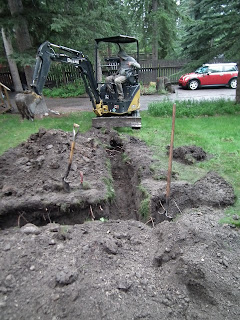The plan was to locate the outflow pipe at the septic tanks, then dig and trace it out. Most septic field run a main (non-weeping) pipe to T junction at a crossing header. The header then feeds a series of (weeping) laterals, which form a pattern kinda like this: Ⴤ (with the fluid flowing in from the bottom).
So our first step was to open the tank and look for the outflow pipe. Turns out its more than 7' down below grade, making digging down to it impractical. But it seemed to be heading off to the front yard, so we took a bee-line and dug a hole. And while we found the gas line first, we found a septic line buried 32" down.
 |
| Look for the white pipe in the lower right corner of the hole |
The white pipe we found was not a weeping pipe, so wasn't a lateral. Probably. So we though we needed to go farther to find the header. And another hole was dug 40" deep on the pipe's trajectory into the yard.
 |
| Pipe in first hole. New hole in the upper right |
 |
| Hole #2 filled in. 45° angle and trench |
 |
| The backhoe starts |
But where was the rest of the field and the other laterals? Turns out the previous owner was around visiting our next door neighbours. So we asked her what she knew about it. She told us that the tanks and field were installed in 1968 or 1969 when the place was still a cabin. When the front addition was done in 1985, the field was damaged, but they didn't know it until the spring when "effluent" started coming up in the disturbed ground caused by the construction. They dug up the damaged section, fixed it by putting in replacement pipes, and re-buried it. What this meant to us (including my engineering contractor) was that the header pipe could be anywhere, and the nice predictable pattern of the pipes we were expecting was probably not so nice and predictable and 90°-like.
So we dug a trench across the yard towards the driveway. And found another lateral, buried 32" down.
 |
| We turn sideways |
 |
| Pipe found, though you can barely see it in this photo |
We decided to dig another hole the other side of the working lateral. Only problem was that the natural gas line runs in this space, and we were reluctant to destabilize this line or hit it. So we guessed, measured & used the backhoe to dig another trench about 7' long and up to 40" deep. We didn't find anything. Poking around with a probe, we think we tapped something almost 32" down and straight underneath the gas line, but chose not to expose it.
Maybe we have 3 laterals. Maybe we only have the 2 we found. Maybe our header is a T shape. Maybe it isn't. Maybe only one lateral is active. Maybe two are. We're so much smarter than we were before.
But now my front yard is a lumpy mudfield.
 |
| Hope the rain washes everything away |

No comments:
Post a Comment